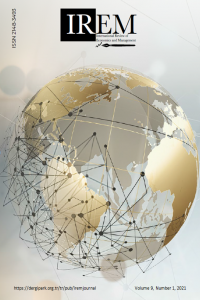AN INTEGER PROGRAMMING FORMULATION FOR THE FUTOSHIKI PUZZLE
Puzzle, Fuhoshiki, Mathematical Formulation, Integer Programming Model
AN INTEGER PROGRAMMING FORMULATION FOR THE FUTOSHIKI PUZZLE
___
- Boreland, B., Clement, G. & Kunze, H. 2015. Set selection dynamical system neural networks with partial memories with applications to Sudoku and KenKen Puzzles. Neural Networks, 68: 46–51. http://dx.doi.org/10.1016/j.neunet.2015.04.008
- Chlond, M.J. 2015. IP in the i. Informs, 16 (1): 39–41.
- Coelho, L.C. & Laporte, G. 2014. A comparison of several enumerative algorithms for Sudoku. Journal of the Operational Research Society, 65: 1602–1610.
- Espasa, J., Gent, I.P., Hoffmann, R., Jefferson, C. & Lynch, A.M. 2021. Using small muses to explain how to solve pen and paper puzzles. ArXiv, abs/2104.15040.
- Haraguchi, K. 2013. The number of inequality signs in the design of Futoshiki Puzzle. Journal of Information Processing, 21(1): 26-32.
- Haraguchi, K. & Ono, H. 2015. How simple algorithms can solve Latinsquare completion-type puzzles approximately. Journal of Information Processing, 23(3): 276–283.
- Hinz, A.M., Kostov, A., KneißI, F., Sürer, F. & Danek, A. 2009. A mathematical model and a computer tool for the Tower of Hanoi and Tower of London puzzles. Information Sciences, 179: 2934-2947.
- Keçeci, B. 2021. A mixed integer programming formulation for Smashed Sums puzzle: Generating and solving problem instances. Entertainment Computing, 36: 1-8. https://doi.org/10.1016/j.entcom.2020.100386
- Lloyd, H., Crossley, M., Sinclair, M. & Amos, M. (2021) (online). J-POP: Japanese puzzles as optimization problems. IEEE Transactions on Games. M.
- Mahmood, A.S. 2019. Design random number generator utilizing the Futoshiki puzzle. Journal of Information Hiding and Multimedia Signal Processing, 10 (1): 178-186.
- Maji, A.K., Jana, S. & Pal, R.K. 2013. An algorithm for generating only desired permutations for solving Sudoku Puzzle. Procedia Technology, 10: 392–399.
- Piette, C., Piette, E., Stephenson, M., Soemers, D. J. & Browne, C. 2019. Ludii and XCSP: playing and solving logic puzzles. IEEE Conference on Games (CoG), 1-4.
- Santos-Garcia, G. & Palomino, M. 2007. Solving Sudoku Puzzles with rewriting rules. Electronic Notes in Theoretical Computer Science, 176: 79–93.
- Wang, W.L. & Tang, M.H. 2014. Simulated annealing approach to solve Nonogram Puzzles with multiple solutions. Procedia Computer Science, 36: 541–548.
- Waziri, M.Y., Saidu, I. & Musa, H. 2010. A mathematical approach on solving Hausa Puzzles in Northern Nigeria. Procedia Social and Behavioral Sciences, 8: 694–699.
- Yu, H., Tang, Y. & Zong, C. 2016. Solving Odd Even Sudoku Puzzles by binary integer linear programming. 12th International Conference on Natural Computation, Fuzzy Systems and Knowledge Discovery (ICNC-FSKD), 2226-2230.
- Futoshiki online puzzles, https://www.futoshiki.org/.
- ISSN: 2148-3493
- Yayın Aralığı: Yıllık
- Başlangıç: 2013
- Yayıncı: Gökhan ÖZER
COVID-19 PANDEMİSİNDE PORTFÖY OPTİMİZASYONU: BİST-30 PAYLARI ÜZERİNE BİR UYGULAMA
AN INTEGER PROGRAMMING FORMULATION FOR THE FUTOSHIKI PUZZLE
KURUMSAL YÖNETİM İLKELERİNİN ÖRGÜTSEL PERFORMANS ÜZERİNDEKİ ETKİSİ
ѕarbaѕt ѕattar ЅALЕH, Serhan GÜRKAN
ÇEVRE VE MUHASEBE ARASINDAKİ İLİŞKİ: LİTERATÜRE DAYALI BİR ARAŞTIRMA
Fatih EKİNLER, Şükran GÜNGÖR TANÇ
